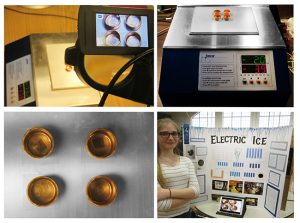Thermoelectric Cold/Hot Plate Replaces Liquid Nitrogen:
TECA’s cold/hot plates utilize thermoelectric cooling, a solid-state method of heat transfer. Also called the Peltier Effect, this technology is valued for its reliability and lack of maintenance needs. For over a decade, TECA cold/hot plates have been cited in peer-reviewed, published academic research papers. Pictured here is our youngest known researcher, a 7th grade student who designed a physics experiment for her school science fair. TECA could not pass up the opportunity to support a budding scientist and lent our Model AHP-301CPV, free of charge.

Lisa, a 7th grader, used the AHP-301CPV in her science fair project, Electric Ice. Following the methods from a paper published in the journal Science, she obtained pyroelectric crystals, which develop an electric field in response to a temperature change. When the pyroelectric crystals are cooled in a controlled manner, their electric field affects the freezing point of the moisture in the air that condenses on them.
Unlike the scientists in the Science paper, Lisa did not have access to large amounts of liquid nitrogen to provide the cooling. Enter TECA Model AHP-301CPV Cold/Hot Plate. The pyroelectric crystals, housed in copper cups, were placed on the cold plate surface. Using the AHP-301CPV’s integral temperature controller and included communications software, Lisa programmed the cooling to ramp down by 2°C per minute, from room temperature to -20°C. A video camera recorded the condensation of the ambient moisture and its subsequent freezing. By comparing the time base of the video with the data captured by the AHP-301CPV’s communications software, Lisa was able to measure the freezing temperature for 3 separate configurations: within a positive electric field, a negative field, and no electric field.